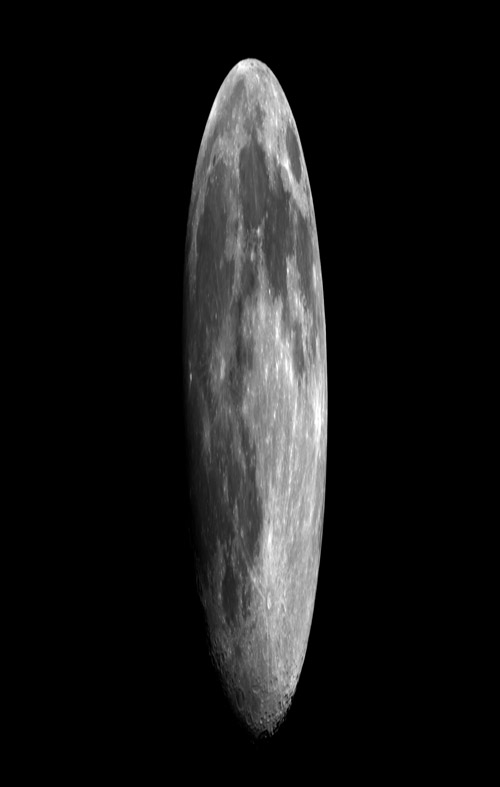Difference between revisions of "LPOD May 25, 2008"
| (One intermediate revision by the same user not shown) | |||
| Line 3: | Line 3: | ||
[[Image:LPOD-May25-08.jpg|LPOD-May25-08.jpg]]<br /> ''image by [http://asterweb.jpl.nasa.gov/gallery-detail.asp?name=Moon NASA/GSFC/METI/ERSDAC/JAROS, and U.S./Japan ASTER Science Team]''<br /> <br /> Add ''Terra'' to the list of spacecraft that have imaged the Moon. Of course its a little harder for ''[http://terra.nasa.gov/About/ Terra]'' to do it since it is an Earth-orbiting satellite. So they turned the spacecraft upside down and imaged the Moon with the [http://asterweb.jpl.nasa.gov/index.asp ASTER] imaging system. They didn't do this so LPOD would have another unusual image but to learn more about their sensors on a well known target. Calibrating sensors by looking at Earth is difficult because the atmosphere constantly changes, absorbing, reflecting and refracting light in unpredictable ways. ASTER acquires images by scanning line by line. It was designed so that the scan rate matches the spacecraft's movement over Earth's surface, but when imaging the much more distant Moon the the two rates are out of synch and distortion results. But a quick stretch of just the horizontal dimension restores [http://asterweb.jpl.nasa.gov/gallery/images/moon-round-bw.jpg roundness].<br /> <br /> ''[mailto:tychocrater@yahoo.com Chuck Wood]''<br /> <br /> <br /> | [[Image:LPOD-May25-08.jpg|LPOD-May25-08.jpg]]<br /> ''image by [http://asterweb.jpl.nasa.gov/gallery-detail.asp?name=Moon NASA/GSFC/METI/ERSDAC/JAROS, and U.S./Japan ASTER Science Team]''<br /> <br /> Add ''Terra'' to the list of spacecraft that have imaged the Moon. Of course its a little harder for ''[http://terra.nasa.gov/About/ Terra]'' to do it since it is an Earth-orbiting satellite. So they turned the spacecraft upside down and imaged the Moon with the [http://asterweb.jpl.nasa.gov/index.asp ASTER] imaging system. They didn't do this so LPOD would have another unusual image but to learn more about their sensors on a well known target. Calibrating sensors by looking at Earth is difficult because the atmosphere constantly changes, absorbing, reflecting and refracting light in unpredictable ways. ASTER acquires images by scanning line by line. It was designed so that the scan rate matches the spacecraft's movement over Earth's surface, but when imaging the much more distant Moon the the two rates are out of synch and distortion results. But a quick stretch of just the horizontal dimension restores [http://asterweb.jpl.nasa.gov/gallery/images/moon-round-bw.jpg roundness].<br /> <br /> ''[mailto:tychocrater@yahoo.com Chuck Wood]''<br /> <br /> <br /> | ||
---- | ---- | ||
| − | '''COMMENTS'''<br /> To [ | + | '''COMMENTS'''<br /> To [[LPOD%20Comments|post comments]] regarding this LPOD, please click [http://the-moon.us/wiki/page/edit/LPOD+May+25,+2008 here] and enter your text in the space below. You will not see the Edit tab unless you register for the wiki. ''Please do not edit the LPOD itself!''<br /> <br /> (1) Aha! Proof at last! The Moon obviously is flat. This must mean that the Earth also is flat. "Flat Earth" supporters everywhere no doubt are rejoicing. <br /> <br /> --Bill<br /> <br /> (2) Looks like the moon in my dreams! (she appeared in all possible shapes...; as a square, rectangular, pencil- or tube-shaped, etc...). And the most perplexing fact of all... I "knew" it was our moon, even when its appearance was not-at-all moonlike! There are strange things going on in the nocturnal cerebral system!<br /> <br /> --Danny C.<br /> <br /> |
---- | ---- | ||
</div> | </div> | ||
Latest revision as of 15:20, 15 April 2018
ORBITAL IMAGE

image by NASA/GSFC/METI/ERSDAC/JAROS, and U.S./Japan ASTER Science Team
Add Terra to the list of spacecraft that have imaged the Moon. Of course its a little harder for Terra to do it since it is an Earth-orbiting satellite. So they turned the spacecraft upside down and imaged the Moon with the ASTER imaging system. They didn't do this so LPOD would have another unusual image but to learn more about their sensors on a well known target. Calibrating sensors by looking at Earth is difficult because the atmosphere constantly changes, absorbing, reflecting and refracting light in unpredictable ways. ASTER acquires images by scanning line by line. It was designed so that the scan rate matches the spacecraft's movement over Earth's surface, but when imaging the much more distant Moon the the two rates are out of synch and distortion results. But a quick stretch of just the horizontal dimension restores roundness.
Chuck Wood
COMMENTS
To post comments regarding this LPOD, please click here and enter your text in the space below. You will not see the Edit tab unless you register for the wiki. Please do not edit the LPOD itself!
(1) Aha! Proof at last! The Moon obviously is flat. This must mean that the Earth also is flat. "Flat Earth" supporters everywhere no doubt are rejoicing.
--Bill
(2) Looks like the moon in my dreams! (she appeared in all possible shapes...; as a square, rectangular, pencil- or tube-shaped, etc...). And the most perplexing fact of all... I "knew" it was our moon, even when its appearance was not-at-all moonlike! There are strange things going on in the nocturnal cerebral system!
--Danny C.